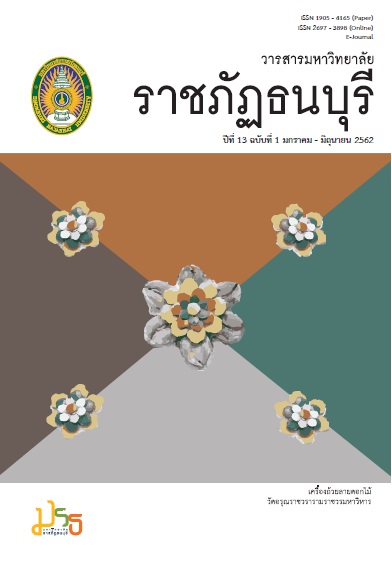การเปรียบเทียบคลื่นไฟฟ้าสมองของนักเรียน ชั้นมัธยมศึกษาปีที่ 1 ขณะทำแบบทดสอบด้านเลขคณิต
คำสำคัญ:
เพศ, ความสามารถของนักเรียน, คลื่นไฟฟ้าสมองที่สัมพันธ์กับเหตุการณ์, แบบทดสอบด้านเลขคณิตบทคัดย่อ
การวิจัยนี้มีวัตถุประสงค์เพื่อ 1) เปรียบเทียบรูปแบบคลื่นไฟฟ้าสมองของนักเรียนขณะทำกิจกรรมแบบทดสอบเลขคณิต วัดมิติกระบวนการทางปัญญา ทั้ง 3 ด้าน (ด้านจำ ด้านเข้าใจ และด้านประยุกต์) จำแนกตามเพศของนักเรียน และความสามารถของนักเรียน และ 2) ศึกษาผลปฏิสัมพันธ์ระหว่างเพศของนักเรียนและความสามารถของนักเรียนที่มีต่อรูปแบบคลื่นไฟฟ้าสมองของนักเรียน ขณะทำกิจกรรมแบบทดสอบเลขคณิต กลุ่มตัวอย่างเป็นอาสาสมัครนักเรียนชั้นมัธยมศึกษาปีที่ 2 (เรียนเนื้อสาระวิชาคณิตศาสตร์ในชั้นมัธยมศึกษาปีที่ 1 มาแล้ว) โรงเรียนปรีชานุศาสน์ จังหวัดชลบุรี จำนวน 40 คน แบ่งเป็นกลุ่มเก่ง และกลุ่มอ่อน กลุ่มละเท่า ๆ กัน เครื่องมือที่ใช้ในการวิจัย แบ่งออกเป็น 6 ชนิด ได้แก่ 1) แบบสอบถามข้อมูลส่วนบุคคลที่ผู้วิจัยสร้างขึ้นเองสอบถามในเรื่องเพศ สุขภาพ และมีการมองเห็นปกติ 2) แบบประเมินความถนัดในการใช้มือขวาของ Oldfield (1971) 3) แบบทดสอบเลขคณิต วัดมิติกระบวนการทางปัญญา ทั้ง 3 ด้าน 4) กิจกรรมการทดสอบด้านเลขคณิต วัดมิติกระบวนการทางปัญญา ทั้ง 3 ด้าน ซึ่งเป็นกิจกรรมทดสอบผ่านทางหน้าจอคอมพิวเตอร์ ด้วยโปรแกรม Stim2 5) เครื่องตรวจคลื่นไฟฟ้าสมอง (EEG) โดยใช้เครื่องขยายสัญญาณ SynAmps RT และหมวก QuikCap แบบ 64 ช่องสัญญาณ 6) เครื่องคอมพิวเตอร์ ซีพียู Intel core i5-2400 (3.1 GHz) ติดตั้งระบบปฏิบัติการ Microsoft Windows XP Professional วิเคราะห์ข้อมูลด้วยค่าสถิติเชิงพรรณา และ Two-Way MANOVA ผลการวิจัยปรากฏว่า ความสูงและความกว้างของคลื่น P300 ขณะทำกิจกรรมการทดสอบด้านเลขคณิต วัดมิติกระบวนการทางปัญญา ทั้ง 3 ด้าน จำแนกตามความสามารถของนักเรียน และเพศของนักเรียนแตกต่างกัน อย่างมีนัยสำคัญทางสถิติที่ระดับ .05 บริเวณจุดอิเล็กโตรด FT8 F2 F6 FC3 FC1 FCZ FC2 FC4 CP2 CP4 CP6 C5 C3 C1 CZ C2 C6 TP7 TP8 T7 T8 CP6 P5 P3 P1 PZ P2 P4 P6 P8 PO7 PO5 PO3 POZ PO4 PO6 PO8 OZ และ O2 ถ้าจำแนกตามความสามารถของนักเรียน ปรากฏว่า ด้านจำ กลุ่มเก่งมีความสูงของคลื่น P300 สูงกว่ากลุ่มอ่อน แต่มีบางจุดอิเล็กโตรดพบว่า ด้านจำ และด้านเข้าใจ กลุ่มอ่อนมีความสูงของคลื่น P300 สูงกว่ากลุ่มเก่ง และยังพบว่า ด้านประยุกต์ กลุ่มเก่งมีความกว้างของคลื่น P300 มากกว่ากลุ่มอ่อน แต่เมื่อจำแนกตามเพศของนักเรียน ปรากฏว่า ด้านจำ ด้านเข้าใจ และด้านประยุกต์ เพศหญิงมีความสูงของคลื่น P300 สูงกว่าเพศชาย แต่มีบางจุดอิเล็กโตรด พบว่า ด้านเข้าใจ เพศชายมีความสูงของคลื่น P300 สูงกว่าเพศหญิง และยังพบว่า ด้านจำ ด้านเข้าใจ และด้านประยุกต์ เพศหญิงมีความกว้างของคลื่น P300 มากกว่าเพศชาย นอกจากนี้ ผลการวิเคราะห์ ความแปรปรวนพหุคูณแบบ สองทาง ยังชี้ให้เห็นว่ามีผลปฏิสัมพันธ์ร่วมระหว่างความสามารถของนักเรียน และเพศของนักเรียนต่อความสูง และความกว้างคลื่น P300 ด้านจำ และด้านเข้าใจ อย่างมีนัยสำคัญทางสถิติที่ระดับ 0.05 บริเวณจุดอิเล็กโตรด FC4 FC6 F2 F6 C3 C1 C4 C6 P1 และ P7
Downloads
เอกสารอ้างอิง
Artz, AF, & Armour-Thomas, E. (1992). Development of a cognitive-metacognitive framework for protocol analysis of mathematical problem solving in small groups. Cognition and Instruction. 9 (2), pp. 137-175.
Bajric, J., Rösler, F., Heil, M., & Hennighausen, E. (1999). On separating processes of event categorization, task preparation, and mental rotation proper in a handedness recognition task. Journal Psychophysiol. 36 (3), pp 399–408.
Benbow, C. P., & Stanley, J. C. (1980). Sex differences in mathematical ability: fact or artifact?. Science. 210 (4475), pp. 1262-1264.
Chittapalo, O. (1998). General Psychology. Bangkok: Chitwat Printing House. (in Thai)
Davis, N., Cannistraci, C. J., Rogers, B. P., Gatenby J. C., Fuchs L. S., Anderson A. W., & Gore, J. C. (2009). The neural correlates of calculation ability in children: an fMRI study. Magnetic Resonance Imaging. 27 (9), pp 1187–1197.
Dehaene, S., Molko, N., Cohen, L., & Wilson, A. J. (2004). Arithmetic and the brain. Current Opinion in Neurobiology. 14 (2), pp. 218–224.
Dickhauser, O., & Meyer, W. (2006). Gender differences in young children's math ability attributions. Psychology Science. 48 (1), pp. 3-16.
Donchin, E., & Coles, M. G. (1988). Is the P300 component a manifestation of context updating?. Behavioral and brain sciences. 11 (3), pp. 357-374.
Ebmeier, K. P., Steele, J. D., MacKenzie, D. M., O'Carroll, R. E., Kydd, R. R., Glabus, M. F., … Goodwin, G. M. (1995). Cognitive brain potentials and regional cerebral blood flow equivalents during two-and three-sound auditory “oddball tasks”. Electroencephalography and clinical neurophysiology. 95 (6), pp. 434-443.
Emmerson, R. Y., Dustman, R. E., Shearer, D. E., & Turner, C. W. (1989). P3 latency and symbol digit performance correlations in aging. Experimental aging research. 15 (3), pp. 151-159.
Fabiani, M., Gratton, G. and Federmeier, K.D. (2007). Event-related brain potentials : Methods, theory, and applications. in Handbook of Psychophysiology. 3rd ed. Cambridge : Cambridge University Press.
Gallagher, A. M., & De Lisi, R. (1994). Gender differences in Scholastic Aptitude Test: Mathematics problem solving among high-ability students. Journal of Educational Psychology. 86 (2), pp. 204-211.
Gallagher, A., Levin, J., & Cahalan, C. (2002). Cognitive patterns of gender differences on mathematics admissions tests. ETS Research Report Series. 2002 (2), pp. i-30.
Ganley, C., & Lubienski, S. (2016). Current Research on Gender Differences in Math, National Council of Teachers of Mathematics. Retrieved December 5, 2016, from http://www.nctm.org /Publications/Teaching-Children-Mathematics/Blog/Current-Research-on-Gender-differences -in-Math/
Ganley, C. M. & Vasilyeva, M. (2011). Sex differences in the relation between math performance, spatial skills, and attitudes. Journal of Applied Developmental Psychology. 32 (4), pp. 235-242.
Guiso, L., Monte, F., Sapienza, P., & Zingales, L. (2008). Culture, gender, and math. Science-New york then Washington. 320 (5880), pp. 1164-1165.
Handy, C. T. (2005). Event-Related Potentials: A Methods Handbook. Cambridge, Mass, USA : MIT Press.
Hedges, L. V., & Nowell, A. (1995). Sex differences in mental test scores, variability, and numbers of high-scoring individuals. Science. 269 (5220), pp. 41-45.
Houlihan, M., Stelmack, R., & Campbell, K. (1998). Intelligence and the effects of perceptual processing demands, task difficulty and processing speed on P300, reaction time and movement time. Intelligence. 26 (1), pp. 9-25.
Iguchi, Y., & Hashimoto, I. (2000). Sequential information processing during a mental arithmetic is reflected in the time course of event-related brain potentials. Clinical Neurophysiology. 111 (2), pp. 204-213.
Johnson, R. (1986). A triarchic model of P300 amplitude. Psychophysiology. 23, pp. 367–384.
Johnson-Laird, P. N. (1994). Mental models and probabilistic thinking. Cognition. 50 (1-3), pp. 189-209.
Kennedy, L., & Tipps, S. (1994). Guiding Children's Learning of Mathematics. Belmont, CA : Wadsworth.
Kirino, E., Belger, A., Goldman-Rakic, P., & McCarthy, G. (2000). Prefrontal activation evoked by infrequent target and novel stimuli in a visual target detection task: an event-related functional magnetic resonance imaging study. Journal of Neuroscience. 20 (17), pp. 6612-6618.
Kong, J., Wang, Y., Shang, H., Xiuzhen Yang, X., & Zhuang, D. (1999). Brain potentials during mental arithmetic-effects of problem difficulty on event-related brain potentials. Neuroscience Letters. 260 (3), pp. 169–172.
Kotchoubey, B. (2006). Event-related potentials, cognition, and behavior: A biological approach. Neuroscience and Biobehavioral Reviews. 30 (1), pp. 42–65.
Krathwohl, D. R. (2002). A revision of Bloom's taxonomy: An overview. Theory into practice. 41 (4), pp. 212-218.
McMillan, J. H., & Schumacher, S. (2010). Research in education: Evidence Based Inquiry. 7th ed. New York : Longman.
Mertens, R., & Polich, J. (1997). P300 from a single-stimulus paradigm: passive versus active tasks and stimulus modality. Electroencephalography and Clinical Neurophysiology/EvokedPotentialsSection. 104 (6), pp. 488-497.
Ministry of Education. (2008). The Basic Education Core Curriculum B.E. 2551 (A.D. 2008) . Retrieved June 5, 2015, from http://www.curriculum51.net/upload/cur-51.pdf (in Thai)
National Council of Teachers of Mathematics Commission on Standards for School Mathematics. (1989). Curriculum and evaluation standards for school mathematics. Natl Council of Teachers of.
National Council of Teachers of Mathematics. (2017). NCTM 2017 Annual Meeting and Exposition. Retrieved August 28, 2017, from http://www.nctm.org/News-and-Calendar/Calendar-Events/NCTM/NCTM-2017-Annual-Meeting-and-Exposition/)
Núñez-Peña, M. I., Gracia-Bafalluy, M., & Tubau, E. (2011). Individual differences in arithmetic skill reflected in event-related brain potentials. International Journal of Psychophysiology. 80 (2), pp. 143-149.
Oldfield, R. C. (1971). The assessment and analysis of handedness: The Edinburgh inventory. Neuropsychologia. 9 (1), pp. 97-113.
Panthong, K., Chadcham, S. and Pitukvattananon, K. (2011). Effects of Item Diffi culty and Students’ Ability on EEG: An Event-Related Potentials Study During Arithmetic Testing. Research Methodology and Cognitive Science. 9 (2), pp. 62-77. (in Thai)
Pauli, P., Lutzenberger, W., Birbaumer, N., Rickard, T.C., & Bourne Jr. L. E. (1996). Neurophysiological correlates of mental arithmetic. Psychophysiology. 33 (5), pp. 522 –529.
Pelosi, L., Holly, M., Slade, T., Hayward, M., Barrett, G., & Blumhardt, L. D. (1992). Event-related potential (ERP) correlates of performance of intelligence tests.
Electroencephalography and Clinical Neurophysiology/Evoked Potentials Section. 84 (6), pp. 515-520.
Polich, J., Alexander, J. E., Bauer, L. O., Kuperman, S., Morzorati, S., O'Connor, S. J., … Begleiter, H. (1997). P300 topography of amplitude/latency correlations. Brain topography. 9 (4), pp. 275-282.
Taylor, P.C.J., & Thut, G. (2012). Brian activity underlying visual perception and attention as inferred from TMS-EEG: A Review. Brain Stimulation. 5 (2), pp. 124-129.
Vaquero, E., Cardoso, M. J., Vazque, M., & Gomez, C. M. (2004). Gender differences in event-related potentials during visual-spatial attention. International journal of neuroscience. 114 (4), pp. 541-557.
Weisberg, R. W., & Reeves, L. M. (2013). Cognition: From Memory to Creativity. John Wiley & Sons.
Wilson, G. F., Swain, C., & Ullsperger, P. (1998). ERP components elicited in response to warning stimuli: the influence of task diffculty. Bio Psychol.. 47 (2), pp. 137–158.
Zamarian, L., Ischebeck A., & Delazer, M. (2009). Neuroscience of learning arithmetic–Evidence from brain imaging studies. Neuroscience and Biobehavioral Reviews. 33 (6), pp. 909 - 925.
ดาวน์โหลด
เผยแพร่แล้ว
รูปแบบการอ้างอิง
ฉบับ
ประเภทบทความ
สัญญาอนุญาต
ลิขสิทธิ์ (c) 2021 มหาวิทยาลัยราชภัฏธนบุรี

อนุญาตภายใต้เงื่อนไข Creative Commons Attribution-NonCommercial-NoDerivatives 4.0 International License.
บทความที่ได้รับการตีพิมพ์เป็นลิขสิทธิ์ของมหาวิทยาลัยราชภัฏธนบุรี
ข้อความที่ปรากฏในบทความแต่ละเรื่องในวารสารวิชาการเล่มนี้เป็นความคิดเห็นส่วนตัวของผู้เขียนแต่ละท่านไม่เกี่ยวข้องกับมหาวิทยาลัยราชภัฏธนบุรีและบุคลากรท่านอื่น ๆ ในมหาวิทยาลัยฯ แต่อย่างใด ความรับผิดชอบองค์ประกอบทั้งหมดของบทความแต่ละเรื่องเป็นของผู้เขียนแต่ละท่าน หากมีความผิดพลาดใด ๆ ผู้เขียนแต่ละท่านจะรับผิดชอบบทความของตนเองแต่ผู้เดียว







